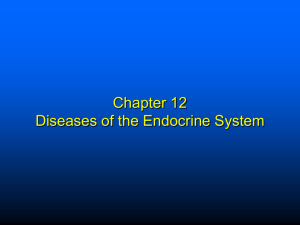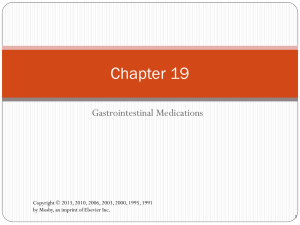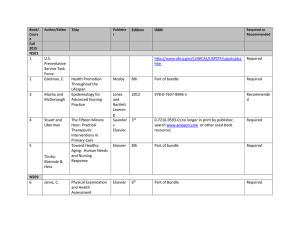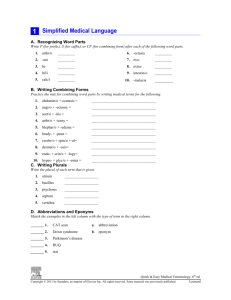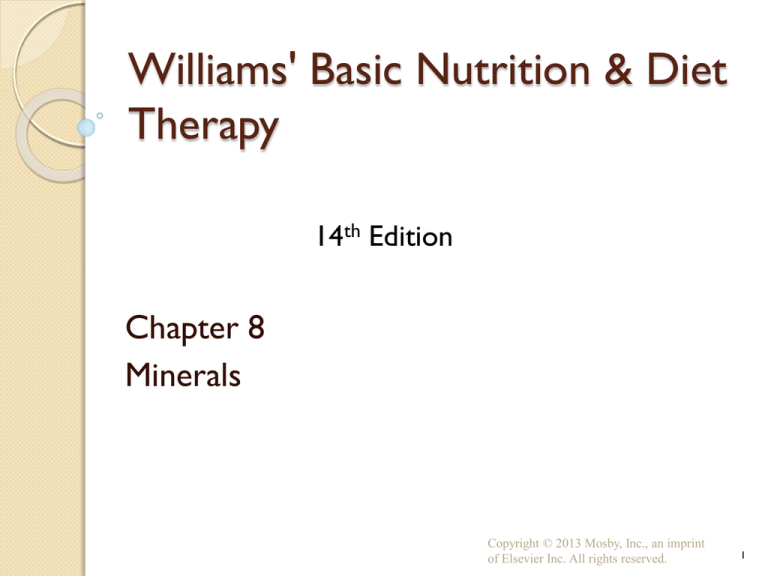
Williams' Basic Nutrition & Diet
Therapy
14th Edition
Chapter 8
Minerals
Copyright © 2013 Mosby, Inc., an imprint
of Elsevier Inc. All rights reserved.
1
Nature of
Body Minerals
1. The human body requires a variety of minerals to
perform numerous metabolic tasks.
Copyright © 2013 Mosby, Inc., an imprint
of Elsevier Inc. All rights reserved.
2
Nature of Body Minerals (p. 128)
Building blocks of life-4 elements*
◦
◦
◦
◦
Hydrogen
Carbon
Nitrogen
Oxygen
25 elements also are essential to human
life
Copyright © 2013 Mosby, Inc., an imprint
of Elsevier Inc. All rights reserved.
3
Classes of Body Minerals
(p. 128)
Classes of body minerals
◦ Major minerals: recommended intake of more than 100 mg/day
Calcium-2% of our total body weight*
Phosphorus
Sodium
Potassium
Magnesium
Chloride
Sulfur
◦ Trace minerals
18 elements
Recommended intake of less than 100 mg/day-smaller amounts
needed in the body*
Copyright © 2013 Mosby, Inc., an imprint
of Elsevier Inc. All rights reserved.
4
Classes of Body Minerals
Copyright © 2013 Mosby, Inc., an imprint
of Elsevier Inc. All rights reserved.
5
Functions of Minerals (p. 129)
Functions of minerals
◦ Building tissue
◦ Activating, regulating, transmitting, and
controlling metabolic processes
Copyright © 2013 Mosby, Inc., an imprint
of Elsevier Inc. All rights reserved.
6
Mineral Metabolism (p. 129)
Mineral metabolism
◦ Digestion: minerals do not require much
digestion
◦ Absorption: rate determined by food form,
body need, tissue health
◦ Transport: enter through portal circulation,
bound to proteins
◦ Tissue uptake: controlled by hormones,
excess excreted in urine
◦ Occurrence in the body: basic forms are free
ions and covalently bound
Copyright © 2013 Mosby, Inc., an imprint
of Elsevier Inc. All rights reserved.
7
Major Minerals (p. 130)
Calcium
Phosphorus
Sodium
Potassium
Chloride
Magnesium
Sulfur
Copyright © 2013 Mosby, Inc., an imprint
of Elsevier Inc. All rights reserved.
8
Calcium (p. 130)
Absorption controlled by 3 factors:
◦ Calcitonin, PTH, vitamin D*
Functions
◦ Bone and tooth formation
◦ Blood clotting-essential for formation of
fibrin*
◦ Muscle and nerve action
◦ Metabolic reactions: absorption of B12,
activation of pancreatic lipase, secretion of
insulin, cell membrane permeability
Copyright © 2013 Mosby, Inc., an imprint
of Elsevier Inc. All rights reserved.
9
Calcium (cont’d) (p. 130)
Requirements: 1000 mg/day for men and
women 19 to 50
Deficiency states
◦ Rickets-softening of bones*
◦ Hypocalcemia-may result in tetany*
◦ Osteoporosis
Toxicity symptoms: hypercalcemia
*Food sources
◦ Milk is the major food source
◦ Green vegetables, fish with bones, fortified food
Copyright © 2013 Mosby, Inc., an imprint
of Elsevier Inc. All rights reserved.
10
Calcium
*Oxalic acid is a compound that is found
in plants such as spinach and it interferes
with the intestinal absorption of calcium
*Phytate-found in grains such as wheat
can bind with calcium and interferes with
its intestinal absorption
Copyright © 2013, 2009, 2005 Mosby, Inc.,
an imprint of Elsevier Inc. All rights
reserved.
Calcium (cont’d) (p. 131)
Copyright © 2013 Mosby, Inc., an imprint
of Elsevier Inc. All rights reserved.
12
Phosphorus (p. 132)
Functions
◦ Bone and tooth formation
◦ Energy metabolism: oxidation of carbohydrate,
fat, and protein; protein construction; cell
function; genetic inheritance
◦ Acid–base balance-chemical buffer that helps
to maintain the ph homeostasis of body
fluids*
Copyright © 2013 Mosby, Inc., an imprint
of Elsevier Inc. All rights reserved.
13
Phosphorus (cont’d) (p. 133)
Requirements: 700 mg/day
Deficiency states: hypophosphatemia
Toxicity symptoms
*Food sources
◦ Milk, milk products, fish, eggs
Copyright © 2013 Mosby, Inc., an imprint
of Elsevier Inc. All rights reserved.
14
Sodium (p. 135)
Functions
◦ Water balance-main function*
Ionized sodium concentration is the major influence
on the volume of body water outside of the cells
(extracellular)
◦ Muscle action
◦ Nutrient absorption
Copyright © 2013 Mosby, Inc., an imprint
of Elsevier Inc. All rights reserved.
15
Sodium (cont’d) (p. 136)
Requirements
◦ AI: 1.5 g/day
◦ UL: 2.3 g/day
Deficiency states: hyponatremia
Toxicity symptoms: salt sensitivity and
hypertension, hypernatremia
Food sources
◦ Table salt, cured meat, canned soups,
processed food
Copyright © 2013 Mosby, Inc., an imprint
of Elsevier Inc. All rights reserved.
16
Potassium (p. 137)
Functions
◦ Water balance
*major intracellular electrolyte
◦ Metabolic reactions
Energy production
Conversion of blood glucose to glycogen
Synthesis of muscle protein
◦ Muscle action
◦ Insulin release
◦ Blood pressure: role in hypertension
Copyright © 2013 Mosby, Inc., an imprint
of Elsevier Inc. All rights reserved.
17
Potassium (cont’d) (p. 137)
Requirements: AI: 4.7 g/day
Deficiency states: hypokalemia
◦ Likely to develop during clinical situations
such as prolonged vomiting or diarrhea*
Toxicity symptoms: hyperkalemia
Food sources
◦ Fruits, vegetables, leafy greens, whole grains,
fresh meats
Copyright © 2013 Mosby, Inc., an imprint
of Elsevier Inc. All rights reserved.
18
Chloride (p. 138)
*Found ECF
Functions
◦ *Digestion: component of hydrochloric acid
◦ Respiration: chloride shift
Copyright © 2013 Mosby, Inc., an imprint
of Elsevier Inc. All rights reserved.
19
Chloride (cont’d) (p. 138)
Requirements: AI: 2.3 g/day
Deficiency states: through vomiting
Toxicity symptoms: from severe dehydration
Food sources: table salt
Copyright © 2013 Mosby, Inc., an imprint
of Elsevier Inc. All rights reserved.
20
Magnesium (p. 139)
Functions
◦ *General metabolism: necessary catalyst for
~300+ reactions in cells
◦ *Protein synthesis: activates amino acids, role
in synthesis and maintenance of DNA
◦ *Muscle action-conduction of nerve impulses
that stimulate muscle contraction
◦ Basal metabolic rate: influences secretion of
thyroxine
Copyright © 2013 Mosby, Inc., an imprint
of Elsevier Inc. All rights reserved.
21
Magnesium (cont’d) (p. 139)
Requirements: ~300 to 400 mg/day
Deficiency states: hypomagnesemia, rare
with balanced diet
Toxicity symptoms: excessive supplements
may produce GI symptoms
Food sources
◦ Nuts, soybeans, cocoa, seafood, peas, green
vegetables
Copyright © 2013 Mosby, Inc., an imprint
of Elsevier Inc. All rights reserved.
22
Sulfur (p. 140)
Part of the amino acids cysteine and
methionine*
Functions
◦ Hair, skin, nails
General metabolic functions
◦ High-energy bond
◦ Transfer energy
Vitamin structure: component of thiamin and
biotin
Collagen structure-important in the building
of connective tissue*
Copyright © 2013 Mosby, Inc., an imprint
of Elsevier Inc. All rights reserved.
23
Sulfur (cont’d) (p. 140)
Requirements: not stated, obtained
through amino acids methionine and
cysteine
Deficiency states: not reported
Toxicity symptoms: unlikely
Food sources: animal proteins
◦ Meat, nuts, soy, fish, cheese, eggs
Copyright © 2013 Mosby, Inc., an imprint
of Elsevier Inc. All rights reserved.
24
Trace Minerals
4. A mixed diet of varied foods and adequate energy
value is the best source of the minerals necessary for
health.
5. Of the total amount of minerals a person consumes,
only a relatively limited amount is available to the body.
Copyright © 2013 Mosby, Inc., an imprint
of Elsevier Inc. All rights reserved.
25
Trace Minerals (p. 140)
Iron
Iodine
Zinc
Selenium
Fluoride
Copper
Manganese
Chromium
Molybdenum
Other essential trace minerals
Copyright © 2013 Mosby, Inc., an imprint
of Elsevier Inc. All rights reserved.
26
Iron (p. 140)
Functions
◦ *Hemoglobin synthesis
◦ General metabolism:
Proper glucose metabolism
Antibody production
Drug detoxification in the liver
Collagen and purine synthesis
*Conversion of carotene to vitamin A
Copyright © 2013 Mosby, Inc., an imprint
of Elsevier Inc. All rights reserved.
27
Iron (cont’d) (p. 140)
Requirements
◦ 8 to 11 mg/day for males
◦ 8 to 18 mg/day for females
*Deficiency states: anemia
Toxicity symptoms
◦ Overdose from supplements
◦ Hemochromatosis
Food sources
◦ Heme
◦ Nonheme
◦ *body absorbs iron more easily when it is taken
along with vitamin C
Copyright © 2013 Mosby, Inc., an imprint
of Elsevier Inc. All rights reserved.
28
Iodine (p. 144)
Functions: participation in thyroid gland’s
synthesis of thyroxine
◦ T3 and T4*
Requirements: 150 mcg/day
Copyright © 2013 Mosby, Inc., an imprint
of Elsevier Inc. All rights reserved.
29
Iodine (cont’d) (p. 145)
Copyright © 2013 Mosby, Inc., an imprint
of Elsevier Inc. All rights reserved.
30
Iodine (cont’d) (p. 145)
Deficiency states
◦
◦
◦
◦
*Goiter
Cretinism
Hypothyroidism
Hyperthyroidism
Toxicity symptoms
*Food sources
◦ Iodized table salt, seafood; depends on soil
content
Copyright © 2013 Mosby, Inc., an imprint
of Elsevier Inc. All rights reserved.
31
Zinc (p. 146)
Important during growth periods such as
pregnancy, lactation, infancy, childhood and
adolescence*
Functions
◦ Enzyme constituent
◦ Immune system
◦ Other functions
Requirements
◦ 11 mg/day for males
◦ 8 mg/day for females
Copyright © 2013 Mosby, Inc., an imprint
of Elsevier Inc. All rights reserved.
32
Zinc (cont’d) (p. 147)
Deficiency states
◦ Poor wound healing
◦ Impaired taste and smell
◦ *acrodermatitis
Rare autosomal recessive disorder that results in
severe zinc deficiency and death
Toxicity symptoms
Food sources
◦ Meat, seafood, legumes, whole grains
Copyright © 2013 Mosby, Inc., an imprint
of Elsevier Inc. All rights reserved.
33
Selenium (p. 148)
Functions
◦ Aids in protection from free radicals
Requirements
◦ RDA: 55 mcg/day
Deficiency states
Toxicity symptoms
*Food sources
◦ Seafood, kidney, liver; depends on soil content
Copyright © 2013 Mosby, Inc., an imprint
of Elsevier Inc. All rights reserved.
34
Fluoride, Copper, Manganese
(p. 149)
Fluoride
◦ *Functions by preventing dental caries
◦ Exceeding UL may cause fluorosis
Copper
◦ *“Iron twin”
◦ Metabolized similar to iron and is a
component of cell enzymes*
Manganese
◦ Inhalation toxicity
Copyright © 2013 Mosby, Inc., an imprint
of Elsevier Inc. All rights reserved.
35
Chromium, Molybdenum, Other
Essential Trace Minerals (p. 150)
Chromium
◦ Previously thought to reduce insulin
resistance
Molybdenum
◦ Inadequate dietary intake improbable
Other essential trace minerals
◦ Aluminum, arsenic, boron, nickel, silicon, tin,
vanadium
Copyright © 2013 Mosby, Inc., an imprint
of Elsevier Inc. All rights reserved.
36
Manganese
Function
◦ Component of cell enzymes
Toxicity
accumulates in the liver and CNS
produces neuromuscular symptoms similar to
Parkinsons disease*
Copyright © 2013, 2009, 2005 Mosby, Inc.,
an imprint of Elsevier Inc. All rights
reserved.
Mineral Depletion
*diuretics
◦ Deplete sodium and potassium
Copyright © 2013, 2009, 2005 Mosby, Inc.,
an imprint of Elsevier Inc. All rights
reserved.
Mineral Supplementation (p. 151)
Life cycle needs
◦ Pregnancy and lactation: for both fetus and
mother
◦ Adolescence: rapid bone growth
◦ Adulthood: postmenopausal women
Clinical needs
◦ Iron-deficiency anemia
◦ Zinc deficiency
Copyright © 2013 Mosby, Inc., an imprint
of Elsevier Inc. All rights reserved.


